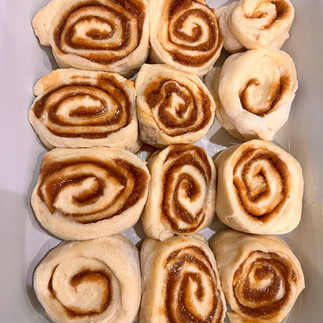how to start making sourdough - the basics
- thechaoscurated

- Mar 23, 2024
- 9 min read
The basics of how to start making sourdough! I'll cover everything you need to know to get started - including what supplies you need to make sourdough, how to keep it alive, a schedule for when you're ready to make some bread, and the best sourdough recipe too! This started for me when SOMEONE (Cassie) gave me a sourdough starter (Vincent Van Dough aka Vinnie) for Christmas, and then basically talked me through the entire process for hours to get to the best loaf of sourdough. And boy is it a process.... so when Vinnie had offspring that I gave it to our babysitter, I promised I'd put together this post so she had all the info in one place. And here we are!

Note: I don't want to micromanage (that would be uncharacteristic, right?)... but I'd recommend you follow this exactly. Sourdough is finicky, and I'm told (by Cassie) that there is some level of flexibility in how you follow the rules... but not a lot. With that, let's get started! ;)
What You'll Need:
For Starting + Maintenance
A starter
Waterbottle Band (or rubber bracelet)
All Purpose Flour
For the Loaf Recipe
Sea Salt
Additional Flours:
Rice Flour
Bread Flour
Scorer (or exacto)
Banneton Basket (or colander + dish towel)
Dutch Oven (3.5L) with Lid
Parchment Paper
How to Become A Sourdough Parent:
Alright, so obviously you need to start with a sourdough starter. You can make your own (Google 'how to make a sourdough starter' and look for high ratings), but honestly I think it's cooler to get one from someone else! If you don't know anyone with a starter, email me (seriously!) and I can get you started.

My friend Cassie sent me a starter (from Chicago through the USPS mail system!) and it originated with a friend of a friend and she continues to pass it along and pass along it's offspring - with one requirement that you name it after a pun. Mine is called Vinnie Van Dough, hers is Doughie Parton... you get it. I saw online that the oldest living sourdough has been alive for 5,000 years... that's more than twice as old as Jesus. Think about that. Anyway, just that fact (making it feel like I'm now part of something big) got me serious about sourdough. Oh also, the fact that Cassie gave Vinnie a name made me really feel like I had to keep this thing alive.
Back to what you need. The first three items above you'll need right off the bat - the starter, a jar, and a band. We already covered the starter, so let's talk about the jar. You need to buy this exact jar (it's sold other places than Amazon linked, but if you go elsewhere, make sure it's the same jar and size). Once you get the jar, you're going to take off the clamps and the rubber piece - you don't need those anymore for this project, so you can recycle them in some way.

Next, you need a band. Why, you ask? It's used to maintain the amount of starter you have at all times - plus if you follow these exact steps, you'll know exactly how much to feed your babe (see next section) each week. Cassie is basically the most organized person ever and must always have a clean look, so she ordered a water bottle band from Etsy with Vinnie's name on it! This is not required - you can use any of those rubber bands or bracelets I know you have laying around the house... but of course it won't be as cute as Cassie's or mine. :) Once you have your band, put it on so that the top of the band is 2 inches from the bottom of the jar.
OK so those are the first three things you need... but there is a lot of other crap you need (as you can see from the list above). Don't let this deter you - this stuff lasts for a long time, and your return of fresh sourdough will 100% be worth it!
Care + Feeding (Weekly)
Your sourdough can live forever (or at least 5k years apparently) if you keep it in the fridge and feed it every week. I feed Vinnie on Sundays - keeping a consistent schedule so I'm less likely to forget. When you're ready to feed, you just need all-purpose flour and water. Here is exactly what to do:
Take the jar out of the fridge.
You will likely notice a thin layer of liquid on top of your starter. If you like your bread sour, keep the liquid in and just stir it with a fork to mix with the starter. If you do not like your bread toooo sour, then pour off that top liquid into your sink.
Use a spoon to take out (and throw away*) any starter that goes above the top of the band. Before you begin the feeding, your starter level should be right at the top of the band.
Dump 1/2 cup of all-purpose flour (directly into the jar with the starter).
Use a fork to stir in 3/8 cup of hot water. (Turn your faucet to the hottest setting - that hot temp is perfect). Do you forget fractions but want to save dishes? For 3/8 just use your 1/4 cup and fill it up one-and-and-a-half times. I'm a genius. You're welcome.
Let it sit on the counter for at least 3 hours but not more than 8 hours. You'll see it rise nearly to the top of the jar. Then it will slowly start to come down. After three hours, you'll see it going back down again. You may even see little bubbles. That is OK.
At that point (and before 8 hours), it's ready to go back in the fridge for the rest of the week.

*This is what it looks like if you don't throw out some starter. There are some other recipes that use random discarded starter if you feel bad throwing it out... but again, you can just toss it as you only need a little bit to make an entire loaf of sourdough each time... and it grows back as you feed it!
Sample Schedule [for Saturday 6pm Dinner Sourdough!]

I've blown out the schedule in the recipe, but I'm keeping it simple in this section so you can see what kind of activities you'll be doing each hour over the 3 day process... Also I love a good project plan and have a hard time resisting a good simplified graphic.
Best Sourdough Loaf Recipe!
For an ingredients list, see the "for the loaf recipe" part of the "What You'll Need" section above. And note that that the timeline for this recipe starts on Friday (Day 2) at 9am (or 9:45am if you're a pro) and has a warm loaf of bread ready for Saturday at 6pm.
Without further ado, the full recipe:
Recipe Day 1 (e.g. Thursday): Do a feeding (and then another) to get your little guy ready for primetime.
Recipe Day 2 (e.g Friday):
6am: Feed one last time, and then you're ready to make the dough!
9am - 10am: Make the dough. (Reminder: Start this step at 9:45am if you're a pro.)
Place a large bowl on the scale. Zero out the scale.
Carefully spoon 70g of starter into the bowl (add/remove to get to the exact measurement). Zero out the scale.
Add 12g of sea salt. Zero out the scale.
Add 350g of warm tap water.
Remove from scale and use a whisk to mix until it all dissolves together.
Put bowl back on the scale. Zero out the scale.
Add 500g of bread flour to the mix.
Remove from the scale and mix together until incorporated (it will be a bit lumpy and that's fine).
10am-10:30am: Let the dough sit in a bowl to rise a bit.
10:30am - noon: It's time to fold! Imagine your bowl is a square. There are 4 folds total, and each set of folds will include 4 steps (one for each 'corner'). For the first set, grab the first 'corner' of your dough and pull it outside the bowl - once it can't stretch any further without breaking, bring that section and fold over the top of the other dough in the bowl. Turn the bowl a quarter turn, and then do the second fold in that next 'corner'. Repeat this a third and fourth time. At this point, you'd folded each corner and therefore one "set" of folds.
10:30am - Do first set of folds (4 steps - one for each 'corner'). Seal the bowl with plastic wrap. Let it sit for 30 minutes on the counter.
11am - Second set of folds. Cover and seal. Let it sit 30 minutes on the counter.
11:30am - Third set of folds. Cover and seal. Let it sit 30 minutes on the counter.
Noon - Fourth set of folds. Your folding is done!
Noon- 8pm: Cover the bowl again with plastic wrap tightly (I even used one of this skinny rubber bands to wrap around the bowl and keep the wrap in place.) Leave the bowl on the counter for 8 hours.
8pm - The dough should have doubled in size while sitting on the counter. Congrats! Now you're ready to prep him to into the fridge. To get him ready for the fridge:
Spread rice flour on your (clean) counter.
Turn the bowl over on top of the rice-floured spot on the counter. The dough will slowly release from the bowl and plop onto the counter top.
Do one more set of folds right there on the counter.
Flip him completely over so the folds are facing the counter.
Shape him into a round form.
Pick up the dough and flip it into the Banneton Basket so your folders are facing up again.
Put the entire thing into a 2 gallon ziplock. Put into the fridge. He can stay in the fridge between 18-36 hours. In this sample schedule, he'll be in there for 20 hours.
Recipe Day 3 (e.g. Saturday):
3:45pm: Put your dutch oven pot into the oven and start pre-heating to 500 degrees (with dutch oven inside). I used my trusty Le Creuset, but you can use any version obviously.
4pm:
Once pre-heated, remove the dutch oven (carefully - it's hot!). Turn the oven down to 450 degrees.
Pull your dough out of the fridge and put parchment paper on top of the dough.
Flip the dough into the dutch oven (parchment paper will now be lining the dutch oven and your dough will be comfortably sitting in the dutch oven).
Carefully score your dough with the razor. A few notes here about scoring because nothing is simple:
Do not use a knife. You must use the razor (or xacto if you insist on not purchasing new tools). I repeat, no knives here as the blade won't be sharp enough!
You must cut from one end all the way to the other. You must extend partway down each side of the loaf in your line.
The depth of the cut should be about 5mm. A deeper cut won't hurt it, but it may result in the bread rising a bit less.
Retracing your line one time can make it a bit cleaner and make sure you really get the whole line.
Cassie demands you score in the shape of either a line or a cross. This seems to be supported by my research online. But... I like to explore and have created other (albeit ugly) shapes as long as they generally follow the rules.. see the "B" above. :)
Cover your dutch oven with the lid.
4:10pm-4:40pm: Put it in the oven for 30 minutes. Reminder: It should be covered and the oven temperature should now be at 450!
4:40pm: Open the oven and remove the lid. Close the oven and reduce the oven temperature to 400 degrees.
4:40-5pm: Continue cooking at 400 degrees (uncovered) for 20 minutes.
5pm: Remove from the oven and take the loaf out of the dutch oven and onto a cutting board.
5pm-6pm: Let it cool! Apparently this step (like all the others) is critical to success... so don't get overeager here. This is why we have a project plan. ;)
6pm: You've done it! You're ready to slice + eat!!
Alright - we admit this is kind of crazy... but once you try your loaf, I bet you'll be hooked!
And if this is all is not enough to convince you... you can use your starter for something even more exciting... homemade cinnamon rolls!
We used this recipe and it was perfect, but there are plenty others out there! You basically use your starter to make other types of dough... and some of them end up tasting like sourdough. But this one, for example, was not sour AT ALL. World is your oyster here.
Hope we've proved it's worth it (and not just because you don't want to disappoint your bff by killing her offspring)... :)
Remember, reach out if you need a starter or have any other advice we can add to the post! Happy baking!

















Comments